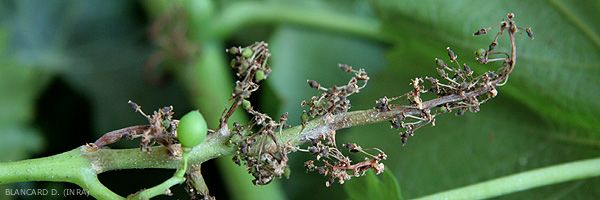
Abiotic disorders of the stalk and bunch
Sag
- Symptoms : Coulure is a non-parasitic disease characterized by abnormal post-flowering drop in fertilized ovaries and young berries.
- Explanatory factors
- Cold temperatures, overcast and rainy weather during flowering;
- The nature of the grape variety, for example Grenache, Merlot, Petit Verdo, Cot grape varieties are sensitive to it in bad weather periods, while other grape varieties reveal genetic setting difficulties;
- Too vigorous a rootstock, excessive manuring;
- Poor training which adversely affects photosynthesis;
- A particular physiological state generated by a biotic (short knotted) or abiotic (deficiency) disease, a disease that disrupts photosynthesis
- Preventive measures
- Optimizing the cultivation of sensitive grape varieties, choosing a poorly vigorous rootstock, poor soil;
- Prune late to delay flowering;
- Control fertilization and vigor, grass if necessary
Millerandage
- Symptoms : This physiological disease results in a reduced development of certain berries compared to other surrounding berries which is linked either to the persistence of the caps on the flowers or to the sterility of the pollen. This phenomenon degrades the visual quality of table grapes and sometimes reduces production in a situation of strong expression.
- Explanatory factors
- Low temperatures, a humid climate disrupting the expulsion of the caps;
- A rootstock promoting this non-parasitic disease;
- A sensitive grape variety, a rather rare situation.
Dryness of the stalk
- Symptoms : Dark brown necrotic lesions appear on the stalk during veraison, often well demarcated at the branches. The stalk and the grapes eventually wilt and dry out.
Explanatory factors
- Several hypotheses have been put forward: local deficiency at the level of the stalk, hormonal phenomenon, water deficit
- A sensitive grape variety such as cabernet-sauvignon, gewürztraminer;
- A vigorous rootstock susceptible to magnesia deficiency;
- Water stress
- Preventive measures
- Choose a rootstock that is not very favorable to the expression of the disease;
- Limit the vigor of the vine;
- Ensure a balanced manure, in particular in magnesia and potassium;
- Spray the bunches and add magnesium-based products to the soil.





